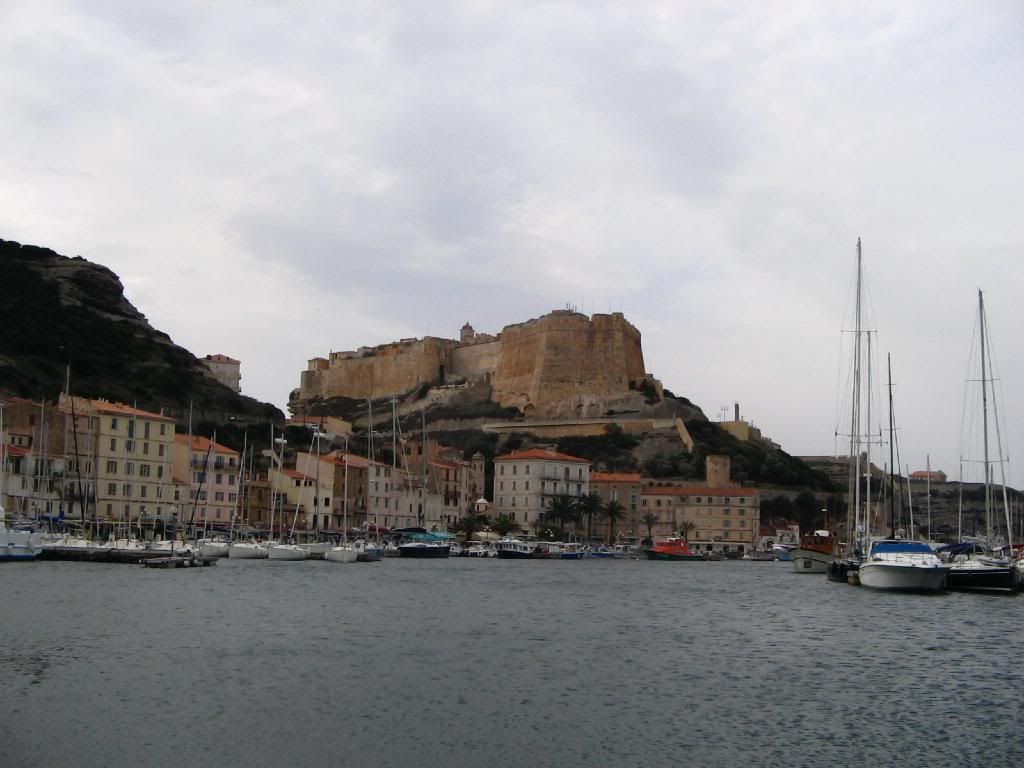
Bonifacio II
It could be that Bonifacio’s first documented appearance is as the town of the cannibalistic Laestrygonians in the Odyssey; Homer’s description of an “excellent harbour, closed in on all sides by an unbroken ring of precipitous cliffs, with two bold headlands facing each other at the mouth so as to leave only a narrow channel in between” fits the port well. The unploughed land that Odysseus comes across inland of the harbour could be a reference to the plain beyond the Bonifacio promontory, and it’s also possible that he Neolithic tribes that once lived in this area where the barbaric attackers of Odysseus’s crew.
In Roman times there was a village on this site, but the town really came into being in 823 AD, when Count Bonifacio of Tuscany built a castle on the peninsula. Like other settlements on the Corsican coast, this one suffered continuous pirate raids, but its key position in the Mediterranean made various powers covet the port. Subject of a dispute between Pisa and Genoa in 1187, Bonifacio eventually fell to the Genoese who then proceeded to massacre the local population and replace them with Liguarians, to whom they offered exemption from tax and customs duty in their ports. Two hundred and fifty families duly settled here, and soon the town developed into a mini-republic with its own constitution and laws governed by elected magistrates called Anziani.
In 1420 Alfonso V of Aragon set his sights on Corsica, and for five months his fleet blockaded the port, hoping to starve the Bonifaciens into submission. Every citizen joined in the defence of the citadel with clergymen, women and children flinging wooden beams, rocks and blinding chalk dust down on the attackers – they even tried to demoralize the enemy by pelting them with cheese, an action masterminded by one Marguerita Bobbia, whose ingenuity is commemorated by a street named after her in the old town. Eventually, a boat was built inside the citadel by the famished defenders, lowered onto the sea from the clifftop and dispatched to seek help from Genoa. Seven galleons were immediately sent to help the Bonifaciens, but they were delayed by contrary winds. Only by donning the armour of their dead soldiers, ringing all the church bells and parading around the town ramparts, were the last surviors of the siege able to buy the time needed for their Genoese rescuers to arrive. When the ships finally appeared, shortly after Christmas, the resolve of the Argonese was decidedly weakened; they decamped shortly after. The Bonifacien bluff had turned the battle.
Another celebrated siege occurred in 1554, when the town was recovering from an outbreak of plague that had claimed two-thirds of the population. Henri II of France arrived with the Turkish fleet, led by the fearsome corsair Dragut. The town held on through eighteen days and nights of cannon fire, and then a member of the eminent Cattacciolo family was dispatched to Genoa to raise help. He was seized on his return by the Turks, who forced him to carry a forged letter refusing them the assistance of the republic, a ploy that brought about Bonifacio’s surrender. The invaders pillaged the town, which was then rescued by Sampiero Corso. There followed a brief period of French rule, which came to an end when the Treaty of Cateau Cambresis returned Corsica to Genoa in 1559.
Thereafter the Genoese port enjoyed relative prosperity until the late 18th century, when the French gained control of the island. No longer permitted their special autonomy; the merchants moved away and the town suffered a commercial decline that was reversed really only with the advent of tourism.
Thanks to
